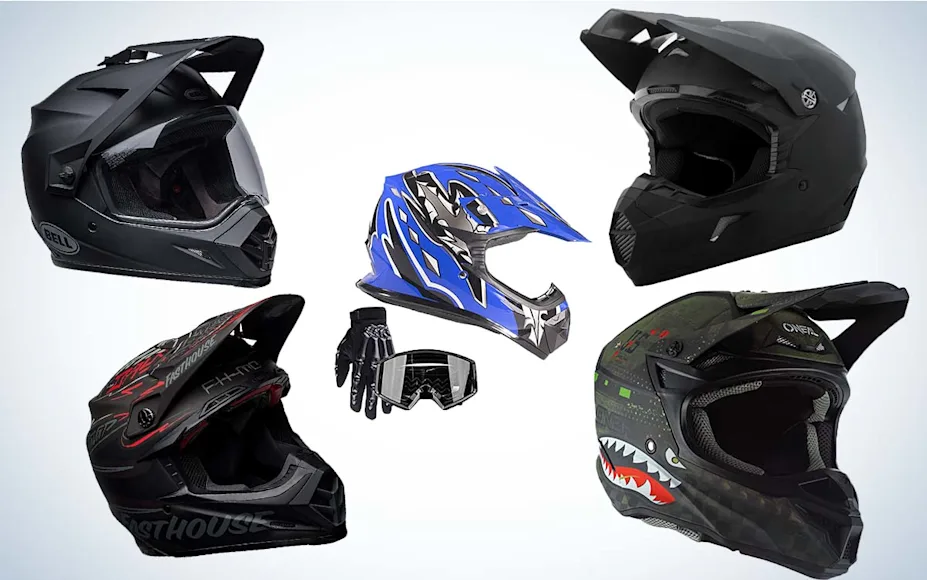_We may earn revenue from the products available on this page and participate in affiliate programs. Learn more ›
_
Best Overall
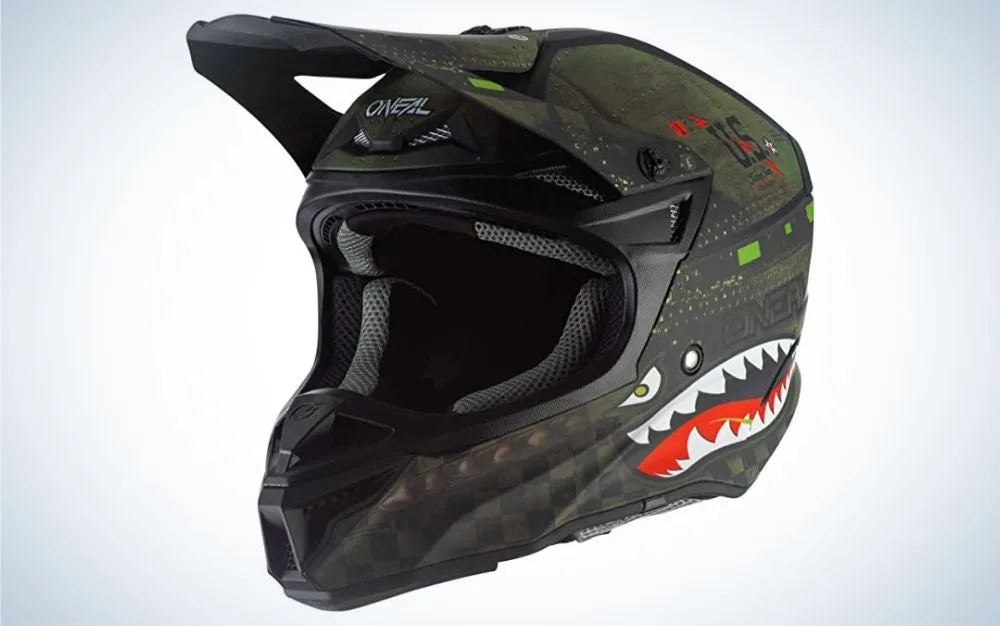
O’Neal 5 SRS Warhawk
Best High-Tech Helmet
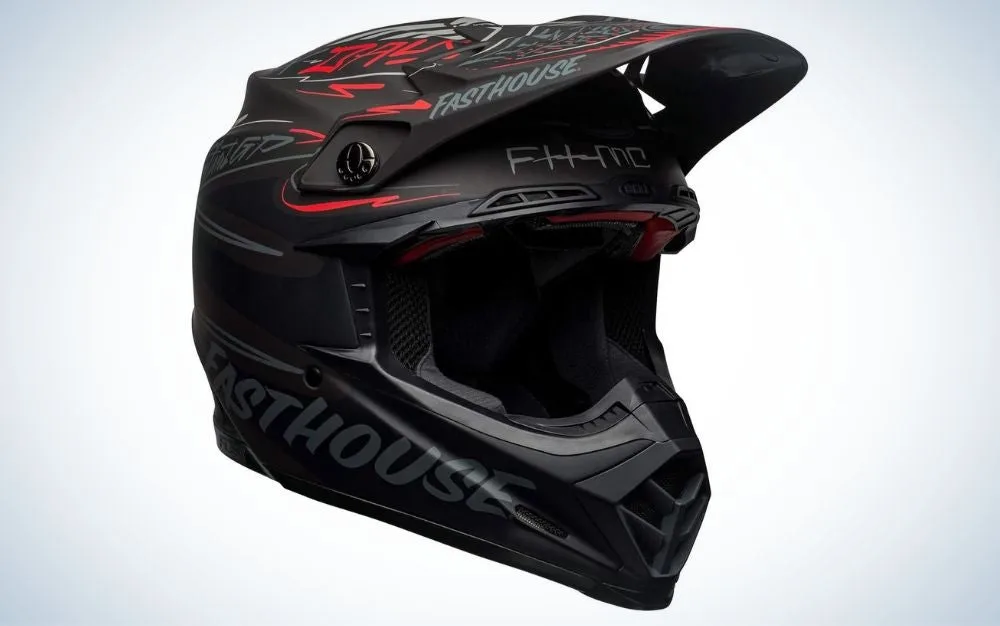
Bell Moto-9 Flex
Best Budget
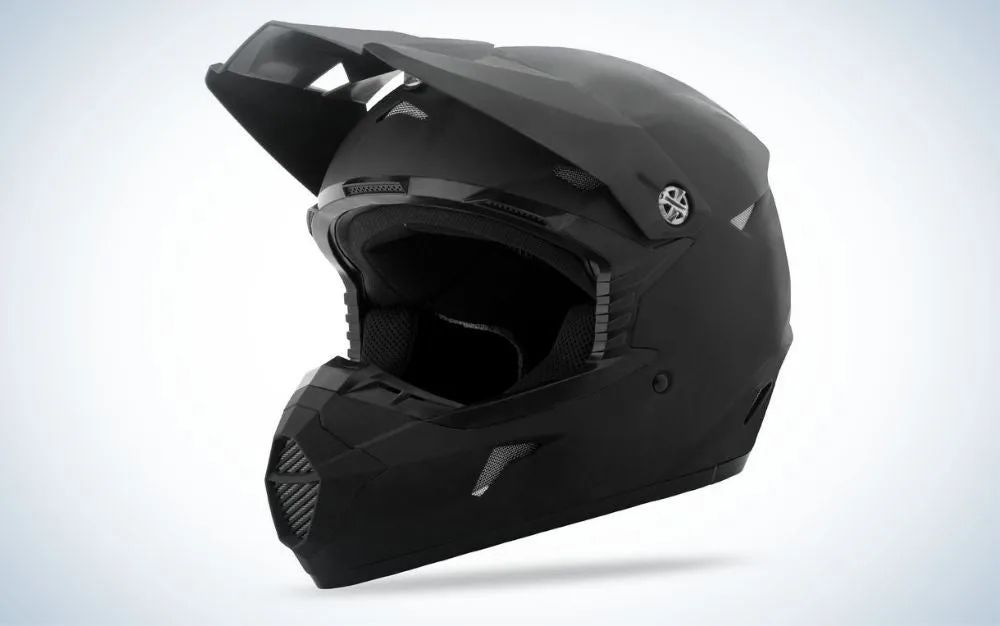
G-MAX MX-46 Solid
Sure, some folks may disagree, but I feel reasonably confident when I say most people would consider their head a relatively important part of their physical make-up. Harm the head. Harm the body. If you’re behind the handlebars, wear a specialized ATV helmet. It’s a pretty simple concept.
And, again with some possible debate, no one knows this more than those who ride All-Terrain Vehicles (ATV). While not without its risks—e.g. careening out of control into a firmly planted Douglas fir or off the edge of a mountain—ATV riding isn’t inherently dangerous. In fact, a bit of digging around on Al Gore’s Internet referencing the ‘World’s Deadliest and Most Dangerous Sports” didn’t even list ATV riding among the Top 10, instead chronicling activities such as bull riding, climbing very large mountains, BASE jumping, gymnastics, and, Surprise…Surprise!, boxing.
But that said, this simple concept remains: Wearing a helmet while riding your ATV is—and I don’t believe there would be any argument here—just a damn good idea. As a volunteer and a wildland firefighter, I’ve seen firsthand the importance of wearing proper Personal Protective Equipment (PPE) while working any number of incidents, including vehicle/occupant extrication, structure fires, and wildland events. The right gloves, footwear, bunker gear, or Nomex, they all are worth their weight in gold when the moment goes south and the ^$@& hits the fan.
And yes, helmets, too. Just ask the timber faller/sawyer friend of mine, a man with decades of experience, who had his STIHL XXX chainsaw kick up and back into his forehead. Fortunately, the bar was stopped by his protective headgear, but not before carving a HUGE chunk out of the reinforced brim. Or ask the severely injured motorcyclist our fire district assisted, a man who would have unquestionably died had it not been for his now-badly damaged BELL helmet. Yes, sir, helmets can and do save lives, and this week, Field & Stream takes an in-depth look at some of the best ATV helmets the market today.
Best Overall: O’Neal SRS Warhawk
Best High-Tech: Bell Moto-9 Flex
Best Budget: G-MAX MX-46 Solid
Best Youth: Typhoon Helmets’ Youth Combo
Best for Safety: Bell MX-9 with MIPS
How I Picked the Best ATV Helmets
For this review, I used two categories—Priority 1 (P1), and Priority 2 (P2)—in evaluating each of the helmets.
Priority 1 included, above all, the equipment’s safety rating/certification, be it DOT, Snell, or, ideally, both. Also in P1 were comfort and weight, ventilation characteristics, and visibility.
In the P2 category, I highlighted parts availability, looks/graphics, and, last but certainly not least, price. Why not price farther up the scale? In my humble opinion, buying an ATV helmet isn’t about assigning a dollar figure to the protection of your overall health and general well-being; that is, your safety. After all, you just paid $7,500 for that new Honda Foreman. What’s $200, particularly if it means saving your scalp. Literally.
Best ATV Helmets: Reviews and Recommendations
Best Overall: O’Neal 5 SRS Warhawk
Best Overall

Specs
Lightweight at only 3 pounds
CoolMax Ultra-Plush liner is removable/washable
Adjustable visor
Multiple air vents
Tough ABS shell
Clear-coated outer graphics with matte finish
Pros
Safety rated by US, UK, and Australian/New Zealand agencies
Awesome ‘military-esque’ look
Ultra-Plush lining is super comfortable
Well-designed ventilation system
Easy to keep clean, thanks to removable liner
Great price at $170
Cons
May be a bit “12-year-old GI Joe” for some adult tastes
Just getting into the ATV racket, getting geared up, and looking for a good helmet that’s not going to break the bank? With the O’Neal 5 SRS (Series) Warhawk
, you’re getting a well-built, well-designed helmet packing plenty of safety rating approvals, and from a long-time trusted player with over five decades of experience in the motocross, and mountain bike (MTB) industry. Combine this with a very reasonable price tag, and j-u-s-t enough bells ‘n whistles to keep most folks intrigued, and you have a clear-cut winner in anyone’s game book.
Yes, the Warhawk looks like something an Avenger might wear, which might turn some of the more ‘mature’ riders off. Still, IMHO, it looks pretty damn cool, not to mention she’s lightweight, well-vented, comfortable, and sure ’nough tough. And I do like the fact you can yank the liner out and wash it, thus greatly decreasing the helmet’s eventual Stink Factor.
Best High-Tech: Bell Moto-9 Flex
Best High-Tech Helmet

Specs
3K Carbon Fiber Shell
Magnefusion cheek pad emergency release system
Flex Energy Management (3-layer impact liner)
Washable X-Static Liner
Eject System Ready – Installed airbag removal system
Velocity Flow Ventilation
Fully adjustable ‘Flying Bridge’ visor
Pros
All the bells and whistle you could hope for
Certified by DOT, Snell, and Economic Community of Europe (ECE)
Three layers of impact protection (low, medium, and high impact)
Carbon shell contributes to light 2.8 pound weight
Ultimate in comfort and unparalleled protection
Excellent post-sale service from a recognized 70-year-old company
Cons
This one will set you back roughly $800
Let’s get the price issue out of the way first, shall we? Duck hunters have their $1,100 waders and $6 per shotshell ammunition. Anglers? A Daiwa Steez baitcasting reel will run you roughly $700. And let’s not forget the $1,000 custom crafted swimbaits. Hell, that’s spendy enough, I’d be afraid to throw it! My point is this: None of these items are 1) worn on your head, and 2) have the potential to save your life. Bell’s Moto-9 Flex
, on the other hand, does. The decision, if you ride, is yours.
This helmet is, quite literally, technology come to life. At the heart of the Moto-9 Flex is a tri-layer liner meant to provide protection during three very different types of impact—low, mid- and high-speed. This innovative design also incorporates what Bell calls a ‘slip zone,’ which allows the liners to rotate/move slightly independently, reducing energy transference should the helmet be impacted angularly. Safety continues as Priority One with the Flex, as proven by Bell’s addition of hardware for an airbag-assisted Helmet Eject System, and pull-out cheek pads that, should the need arise, allow emergency personnel to remove the helmet easily.
Best Budget: G-MAX MX-46 Solid
Best Budget

Specs
DOT approved
Industry-leading 19 air vents
Removable/washable liner
High flow mouth vent with washable filter
Vented ‘roost’ (dirt/debris/mud) deflector
Fully adjustable visor
Lightweight at only 2.8 pounds
Pros
Street price between $80 and $100, source dependent
Good airflow and circulation, thanks to 19 vents
Replaceable CoolMax inner lining allows for custom fit
Not a bad looking helmet
Cons
Meets minimum safety requirements (DOT) only
No bells ‘n whistles; Plain Jane but works
Unless you have a knack for falling in the outhouse and coming out wearing a new straw hat, you’re not going to buy a Porsche 911 —Okay, a ’65 El Camino, white on black, with a 396—for $14. If you’re looking for everything under the sun in terms of helmet accessorizing, technology, and the Cool Factor, it’s going to cost you. Such is the case with G-MAX’ MX-46 Solid
; that is, you spend $100, and you get $100, give/take, worth of helmet. But it’s a good SOLID (Get it?) helmet, complete with a DOT safety rating and enough gingerbread to keep most first-year riders content. And protected, which is the whole reason behind a helmet, eh?
Darth Vader-esque is how I’d describe the all-black matte MX-46, which in and of itself is pretty cool. So chalk one up in the LOOKS Category. The helmet features plenty of intake/outflow vents, and a handful of owner-dictated tweaks, e.g. an adjustable visor and customizable interior, that help personalize the equipment. And at only 2.8 pounds, the MX-46 is light, and that in turn bumps the comfort factor up a bit. A more-than-adequate, albeit bare bones helmet for under $100. You got a winner here!
Best Youth: Typhoon Helmets’ Youth Combo
Best Youth
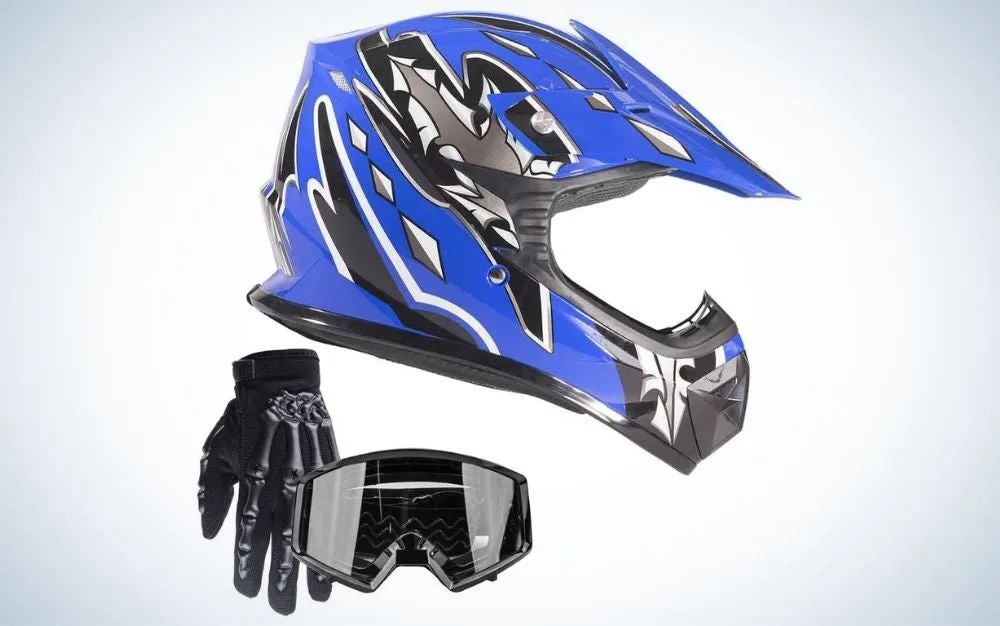
Specs
Combo includes helmet, goggles, and gloves
DOT approved
Removable/washable liner
True ‘youth’ size; not modified or downsized adult models
Helmet weight is under 3 pounds
Channeled side plates help hold goggle straps in position
Goggles – Anti-fog/Anti-scratch lens
Gloves – Sure-Grip synthetic leather palm pad
Pros
Tremendous bargain at $60/combo
Huge selection of colors and pattern schemes
Goggles sized to precisely fit helmet opening
Plenty of intake/outflow ventilation
Great ‘starter’ kit
Cons
None, as I’m not sure how you beat this deal
Nothing fancy about Typhoon Helmets’ Youth Combo
. No cutting edge technology. No This and no That. However, what this well-priced and well-designed gear kit offers is an excellent way of outfitting your young rider, without having to sell a kidney or take out a second mortgage. That’s saying a lot right there.
Single safety approval (US/DOT) here, but that’s fine, as she’s still covered by the Powers That Be. Interestingly, Typhoon builds what they call a ‘true’ youth helmet here; not a 16-gauge autoloader on a 12-gauge frame, à la Remington’s first re-entry into the sub-bore market back in The Day. Rather, this isn’t an overstuffed adult lid that’s been Frankenstein’d into a kid’s helmet. At just under three pounds, its light and comfortable, and features all the things you’d find in a $300 helmet—visuals, graphics, adjustments here ‘n there, ventilation, and convenience of maintenance—with the three-bill price tag. AND, let’s not forget it’s a combo, which means, for that initial investment, you’re also getting a set of goggles (Lexan lens; silicone gelled elastic strap; anti-fog/scratch) and a decent pair of riding gloves, some imprinted with cool skeleton finger bones. All in all, a tip of the ‘ole cap to a good all-inclusive combo here.
Best for Safety: Bell MX-9 with MIPS
Best for safety
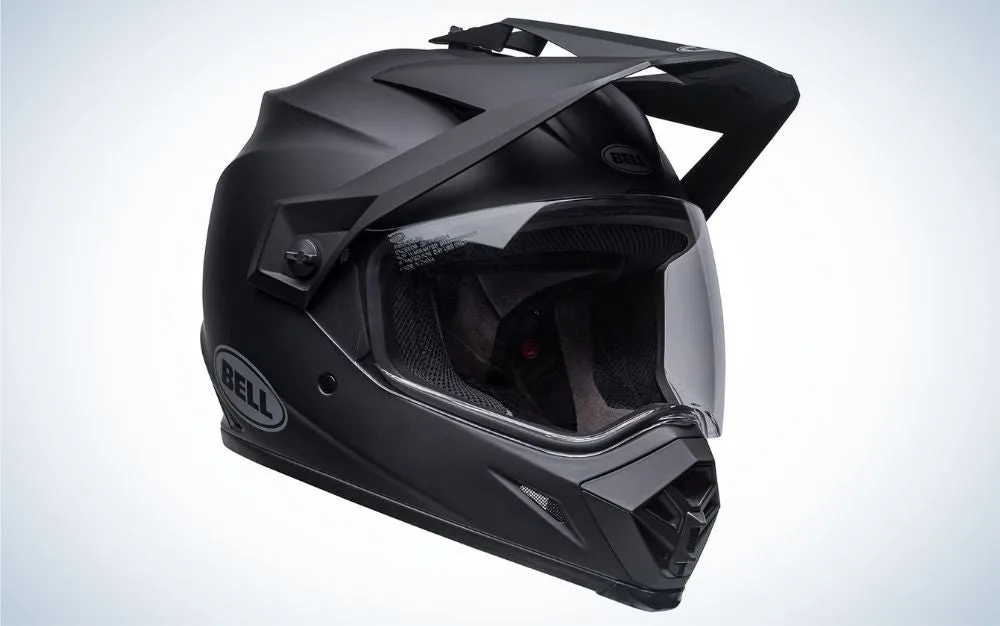
Specs
Equipped with MIPS (Multi-directional Impact Protection System)
Available in three different shell sizes
Anti-bacterial liner
Tough polycarbonate shell
Fully adjustable visor
Velocity Flow ventilation
Pros
DOT/ECE safety certification
Relatively light at 3.3 pounds
Wide array of innovative safety features
Backed by one of the best names in the industry
Cold weather kit available
Good price point at $170-$200
Cons
Some might consider it spendy, but in The Grand Scheme, it’s not
Another one from the folks at Bell Helmets. So where to begin. First off and visually, the MX-9
just looks…well…really REALLY cool. The lines are nice. The profile is bad-ass. The high-rise Flying Bridge Visor sets the whole thing off. If you’re into looks, the MX-9 isn’t going to disappoint.
But good looks ain’t going to save your noggin should something bad happen. It’s design, and in this case technology, that saves the day. The MX-9 features what Bell calls ‘MIPS,’ or the Multi-Directional Impact Protection System, which allows for rotation inside the helmet on impact, rather than the helmet holding the head static. Here, a little ‘give’ is a good thing. This MIPS tech, along with the MX-9’s damn near indestructible ABS/poly shell—Available in three sizes, plus additional padding for a precise rider-to-rider custom—creates a wonderfully safe environment for your head.
And the goodness doesn’t end there. Accessories including a cold weather kit (helmet liner/breath warmer), custom visors, and cheek pads are available from Bell…and all this, add-on dependent, for right around $225.
What to Consider When Choosing an ATV Helmet
I’m going to use the word ‘obviously’ here, but obviously, a good, if not stellar safety rating is one of the, or perhaps THE biggest variable to be considered when researching a new ATV helmet. However, there are a handful of additional factors that should go into making your final decision, such as …
Safety Record
This one’s, without question, worthy of repeating. In the United States, it’s the Department of Transportation (DOT) who’s responsible for putting their ‘safety sticker of approval’ on any and all helmets; that is, it’s the DOT who sets the minimum safety requirements for a helmet. So you’re looking for headgear with at least a DOT rating. There are other safety standards as well
, such as Snell
, and a helmet may be rated by two or more agencies.
Price Point
It goes without saying that the best helmet on the planet does you no good if you can’t afford it. When you’re talking about your brain pan, don’t go cheap. Buy the best your wallet will allow, but shop around first, as there are deals to be had out there.
Comfort and Weight
I look at a helmet like I do my wildland boots. I’m going to be wearing the damn things for a long, LONG time, so they better fit, and fit well. Same with a helmet. It’s tough, though, to test drive a helmet you’ve bought online; however, with research, it’s possible to find a match without ever having crammed your noggin into the gear. Better, understandably, to put it on, just to make sure A) it fits, and B) it’s going to be comfortable when you’re riding for six hours. Weight is also a factor. Too light, and safety (might be) questionable; too heavy, and you’re going to need a chiropractor to put your neck back where it belongs. The ballpark is three pounds; maybe an ounce or two more.
Visibility
Being able to see with a helmet on is…well…nice. Whether you opt for a full face shield or goggles, unimpaired vision is definitely a ‘plus.’
Ventilation
The ventilation designed into modern ATV helmets is light-years ahead of what it was back in The Day. Today’s helmets—or at least the ones you should be looking at—feature multiple vents and venting strategies, i.e. intake vents, outflow vents, cooling, and circulation. How the helmet channels or routes inside air is also important, as this calculated circulation not only keeps you cool, but helps prevent visor fog.
Parts Availability
Are parts and accessories —OEM/factory, or aftermarket—readily available, things like specialty face shields, chin straps, graphics, padding, or even Bluetooth-enabled sound systems?
FAQs
Q: How much should a good ATV helmet cost?
As ATVs range widely in price from high to low, so, too, do ATV helmets. An approved ‘good enough’ helmet may cost as little as $100. However, you’re getting what you pay for in terms of amenities, appearance, aftermarket modifications, ventilation, and, perhaps most significantly, fit/comfort. High-end helmets can run as high as $400 or more, but include ‘cool’ things like heated (fog-free) face shields, customizable liners, magnetic straps, and dual safety ratings. Fortunately, there are a wealth of options in that $150-$250 middle ground.
Q: What size ATV helmet do I need?
Everyone’s head is different, albeit perhaps just slightly; still, a good helmet is also one that fits well. So what size? Most, if not all manufacturers will include on their website a chart that determines a particular helmet size, e.g Small, Medium, Large, based on the circumference—the measure in inches/centimeters fully around an object—of your head. In other words, measure around your head, and that measurement will translate into a helmet size.
Q: What style/type of ATV helmet do I need?
First off, ATV helmets and motorcycle—NOT motocross —helmets, though sharing some similarities, are indeed different. For one, road/highway bikes (motorcycles) aren’t typically subjected to the dust and dirt seen in ATV situations. Thus, a full-face helmet, complete with protruding mouth/chin protection, along with multiple intake/outflow vents, is more suitable for an ATV rider than it would be for an individual riding cross-country on a Harley-Davidson. In short, full-face ATV-specific helmets offer the utmost in protection for off-road riders.
Best ATV Helmets: Final Thoughts
Best Overall: O’Neal SRS Warhawk
Best High-Tech: Bell Moto-9 Flex
Best Budget: G-MAX MX-46 Solid
Best Youth: Typhoon Helmets’ Youth Combo
Best for Safety: Bell MX-9 with MIPS
There are a TON of choices out there when it comes to ATV helmets. Don’t believe me? Miss Google, when asked (by me), returned some 67.5 million responses to my simple inquiry: “ATV Helmets.” Much of your final decision is going to come down to both a financial choice and what I’ll call one of appearance; that is: Is the helmet cool? Or are you going to look like your Grandpa in his 1975 Buick LaSabre … which is actually a VERY cool ride, though perhaps not to the 23-year-old ATV rider. The bottom line? Get the best-fitting, most comfortable helmet you can afford, wear it religiously, and then ride safe.
Why Trust Us
For more than 125 years, Field & Stream has been providing readers with honest and authentic coverage of outdoor gear. Our writers and editors eat, sleep, and breathe the outdoors, and that passion comes through in our product reviews. You can count on F&S to keep you up to date on the best new gear. And when we write about a product—whether it’s a bass lure or a backpack—we cover the good and the bad, so you know exactly what to expect before you decide to make a purchase.

